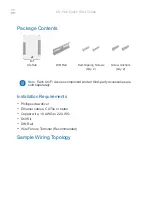
266
Rockwell Automation Publication 1769-UM021G-EN-P - October 2015
Chapter 10
Develop Applications
A task provides scheduling and priority information for a set of one or more
programs. Configure tasks as continuous, periodic, or event by using the Task
Properties dialog box.
Figure 42 - Configuring the Task Type
This table explains the types of tasks you can configure.
Table 33 - Task Types and Execution Frequency
Task Type
Task Execution
Description
Continuous
At all times
The continuous task runs in the background. Any CPU time that is not allocated to other operations (such as motion,
communication, and other tasks) is used to execute the programs in the continuous task:
•
The continuous task runs constantly. When the continuous task completes a full scan, it restarts immediately.
•
A project does not require a continuous task. If used, there can be only one continuous task.
Periodic
•
At a set interval, such as every
100 ms
•
Multiple times in the scan of
your other logic
A periodic task performs a function at an interval:
•
Whenever the time for the periodic task expires, the task interrupts any lower priority tasks, executes once, and returns
control to where the previous task left off.
•
You can configure the time period from 0.1…2,000,000.00 ms. The default is 10 ms. It is also controller and configuration
dependent.
•
The performance of a periodic task depends on the type of Logix5000 controller and on the logic in the task.
•
The periodic task processes I/O data for CompactLogix™, FlexLogix™, DriveLogix™, and SoftLogix™ controllers with the
following considerations:
–
For CompactLogix, FlexLogix™, and DriveLogix™ controllers, operates at priority 6
–
For SoftLogix™ controllers, operates at Windows priority 16 (Idle)
–
Higher-priority tasks take precedence over the I/O task and can affect processing
–
Executes at the fastest RPI you have scheduled for the system
–
Executes for as long as it takes to scan the configured I/O modules
Event
Immediately when an event occurs
An Event task performs a function only when an event (trigger) occurs. The trigger for the Event task can be the following:
•
A consumed tag trigger
•
An EVENT instruction
•
An axis trigger
•
A motion event trigger
•
Module input data state change
IMPORTANT
: With Logix Designer application, version 21.00.00 or later, you can use this trigger with 1756 ControlLogix®,
1789 SoftLogix™, and CompactLogix 5370 L1 applications.















































